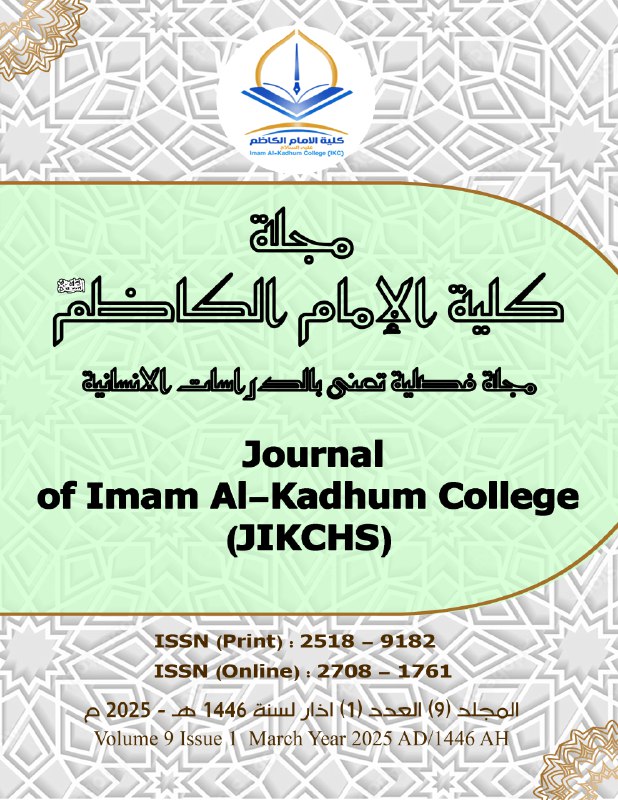The Brethren of (Ikhwan al-safa wa khulan al-wfa) and Their EpistlesA Sociological and Intellectual Study of Their Origin and Development
DOI:
https://doi.org/10.61710/174V9N1Keywords:
The Brethren of Purity, The Epistles of the Brethren of Purity, Islam, Religion, Philosophy, Concealment, SecrecyAbstract
In light of the deteriorating social and political conditions that the Islamic world witnessed during the 3rd and 4th centuries of the Hijra, a group known as (The Brothers of "Ikhwan al-safa wa khulan al-wfa") emerged. This group surrounded itself with an aura of secrecy and confidentiality. It appears to have been numerous and composed of individuals from various strata of society. However, there is insufficient historical evidence regarding the origin of this group, the number of its members, its prominent figures, and its goals. As a result, several theories emerged to determine the identity, direction, and doctrine of this group. The group also established an internal system, and scholars and researchers have disagreed on the objective and purpose behind the formation and organization of the Brothers of Purity. Perhaps the reason for this disagreement lies in the diversity of sciences and knowledge presented in their epistles, which covered various fields of knowledge at that time.
As for the epistles attributed to this group, they did not carry the names of their authors or author. This led to significant differences regarding the identity of the author or authors of these letters, their identities, and their doctrinal affiliations. Consequently, several theories have been put forward by various writers and researchers, both Muslim and non-Muslim, to determine the identity of the authors of the Epistles of the Brothers of Purity. Disagreement also arose regarding the time of the composition of these epistles. Numerous studies have emerged addressing the content of these epistles, their number, their structure, and their editions. The research also pointed out some formal and substantive issues related to these epistles.
References
أحمد ابن تيمية. (2004). مجموع الفتاوى (المجلد ط2). المدينة المنورة: مجمع الملك فهد لطباعة المصحف الشريف.
إخوان الصفا. (1957). رسائل اخوان الصفاء وخلان الوفاء،. بيروت: دار صادر.
أنور الحندي . (4 يناير, 1999). رسائل إخوان الصفا مؤامرة على الإسلام. منار الإسلام، الصفحات 122 - 141.
جمال الدين علي بن يوسف بن إبراهيم القفطي. (2005). إخبار العلماء بأخبار الحكماء (المجلد ط1). بيروت: دار الكتب العلمية.
سيد حسين نصر. (2020). رسائل أخوان الصفاء هويتها ومحتواها (المجلد ط1). عمان: وقفية الأمير غازي للفكر القرآني.
سيد محمد ثقفي. (صيف, 1376 ش). آراء ونظريات إخوان الصفا. الحكومة الاسلامية، صفحة 147.
شمس الدين محمد بن أحمدبن عثمان الذهبي. (1995). سير أعلام النبلاء (المجلد ط3). بيروت: مؤسسة الرسالة.
صادق النور. (21 اغسطس, 2021). منتدى آل راشد. تم الاسترداد من موقع منتدى آل راشد: https://aalrashed.ahlamontada.com/t3058-topic
طه حسين. (1928). رسائل إخوان الصفا (المجلد ط1). القاهرة: الطبعة المصرية.
عادل العوا. (1993). حقيقة إخوان الصفا (المجلد ط1). الأهلي للطباعة والنشر والتوزيع.
علي بن محمد بن العباس أبو حيان التوحيدي. (2005). الإمتاع والمؤانسة (المجلد ط1). بيروت: المكتبة العصرية.
فؤاد معصوم. (1988). إخوان الصفا فلسفتهم وغايتهم (المجلد ط1). دمشق: دار المدى للثقافة والنشر.
محمد عبد الحميد الحمد . (1998). صابئة حران وإخوان الصفا (المجلد ط1). دمشق: مطبعة الاهالي للطباعة والنشر.
محمود إسماعيل. (1996). إخوان الصفا رواد التنوير في الفكر العربي. القاهرة: عامر للطباعة والنشر.
محمود إسماعيل. (2021). نهاية أسطورة نظريات ابن خلدون مقتسبة من نظريات إخوان الصفا (المجلد ط1). الكويت: رؤية للنشر والتوزيع.
Downloads
Published
Issue
Section
License
Copyright (c) 2025 Journal of Imam Al-Kadhim College

This work is licensed under a Creative Commons Attribution-NonCommercial-NoDerivatives 4.0 International License.




